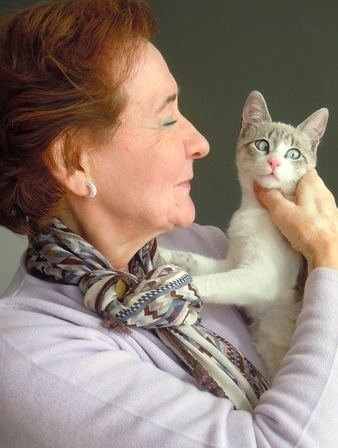 “Oh, if only she could talk!”
“Oh, if only she could talk!”
How many times have you said that about your feline friend?
The truth is that your cat talks to you all the time, but you just don’t speak the same language. While you might have dismissed the sounds your cat makes as meaningless, a recent article in Better Homes and Gardens will set you straight on that.
Here’s a rundown of what the magazine reports each particular vocalization actually means.
“Meow.”
The basic unit of cat vocalization, the meow can serve as a greeting, a call, a scolding, a query, an expression of pain or hunger, or boredom, a request, a demand, a suggestion, a summons – and only to humans. Cats don’t communicate with other cats with a “meow,” so if you hear it, it was probably meant for you.
Like humans, cats can alter their volume and intonation to suit the message. If you were gone overnight, you’ll likely hear some strident meows, chastising you for your absence. (Which we know almost always gives way to headbutts eventually.)
Pay some attention to the situations in which your cat meows and you’ll soon be able to distinguish between “I’m hungry,” “I want treats,” “Scratch my belly,” “Stop scratching my belly” and “I hate the dog. Why did you get him?”
Purring
The biggest misconception is that a purring cat is a happy cat – but not necessarily so.
Scientists believe the physical act of purring can actually help keep the cat healthy by stimulating their muscles and bones, but purring can also be way that cats communicate with their kittens and their humans, says Better Homes and Gardens. It is now believed that purring occurs when the laryngeal muscles of the cat twitch, causing the vocal cords to separate as the cat inhales and exhales. Regardless, the sound of a happy, relaxed kitty purring is one of the sweetest sounds in the world.
“Chirp. Chatter.”
Cats are obligate carnivores, and right outside your window is a kitty buffet of chipmunks, squirrels and birds. Cats will often emit birdlike sounds, and it’s not for our amusement. Instead, cats are actually trying to lure their prey close enough to catch. Big black ones that caw, little black-capped ones that whistle – they’re all just taunting your cat from outside the glass (or at least it’s likely your cat feels that way). When your cat gets frustrated at not being able to bag the bird that’s right outside the window, you might hear a kind of chattering sound. You can think of it as a feline release valve for the desperate urge to pounce on prey that’s out of reach.
“Hiss.”
This usually needs no explanation. A cat feeling angry, cornered, trapped, frightened or combative will issue forth with its most menacing hiss – sometimes with a growl for flourish.
Caterwauling
Who among us hasn’t been ripped from a sound sleep by the hellacious caroming of a neighborhood cat? Whether it’s feline singles night, a new cat on the block or wildlife that has wandered too close to home for your kitty’s comfort, the unmistakable sound of caterwauling means someone’s ready to rumble. The magazine points out yet another reason to spay or neuter your cat – it will cut down the likelihood that you’ll be roused by the caterwauling of your own normally docile feline when she’s in the throes a hormonal experience.
Now that you know the language, you can make your cat even more comfortable with one of the elegant cat townhouses from The Cat’s Inn. Our townhouses are a great place for cats to relax and play, and if you operate a shelter or veterinary practice, having these handy units available for your cats will help keep the cross-chatter and combativeness between your cat guests at a minimum. With space for cats to stretch, sleep and even hide, they’re a perfect choice for your operation. To learn more, check out our different popular models online now or call us today at 877-228-7466 to discuss your specific needs.

My cat does that all of the time.